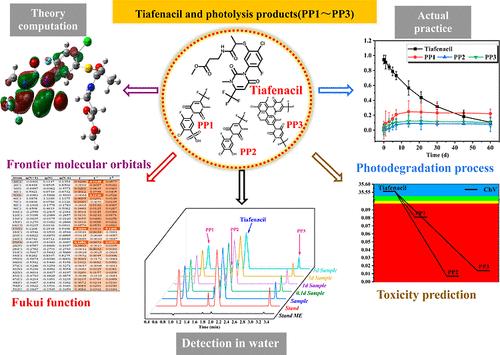当前位置:
X-MOL 学术
›
J. Agric. Food Chem.
›
论文详情
Our official English website, www.x-mol.net, welcomes your
feedback! (Note: you will need to create a separate account there.)
Development and Application of a New QuEChERS Method Coupled with UPLC-QTOF-MS/MS for Analysis of Tiafenacil and Its Photolysis Products in Water
Journal of Agricultural and Food Chemistry ( IF 5.7 ) Pub Date : 2024-11-19 , DOI: 10.1021/acs.jafc.4c04618 Zhie Zhou, Shujie Zhang, Jian Chen, Wenjing Luo, Fenfen Kang, Yonglin Ren, Wenwen Zhou
Journal of Agricultural and Food Chemistry ( IF 5.7 ) Pub Date : 2024-11-19 , DOI: 10.1021/acs.jafc.4c04618 Zhie Zhou, Shujie Zhang, Jian Chen, Wenjing Luo, Fenfen Kang, Yonglin Ren, Wenwen Zhou

|
This research centered on the novel pyrimidinedione herbicide, tiafenacil. Residues of tiafenacil and its three photolysis products (PP1 to PP3) in water were analyzed using advanced QuEChERS and UPLC-QTOF-MS/MS techniques, reaching a low limit of quantitation (LOQ) of 10 μg/L. Calibration curves exhibited a high degree of linearity (R2 ≥ 0.993) over a concentration range of 0.01 to 1.00 mg/L. Method validation demonstrated high precision, with intraday relative standard deviation RSDr ≤7.9% and interday RSDR ≤ 6.1%, along with high accuracy (recoveries from 94.4% to 105.0%). Using density functional theory (DFT) at the B3LYP/6-311g (d) level, we calculated the electronic properties of tiafenacil and its PPs (PP1 to PP3). Additionally, frontier molecular orbital (FMO) and fukui function analyses were conducted to explore HOMO–LUMO energies, determine energy band gaps for these substances, and predict reactive sites for their electrophilic, nucleophilic, and radical reactions. Significantly, ecotoxicity assessment, including ECOSAR predictions and acute toxicity tests, revealed that the PPs exhibited higher ecotoxicity to aquatic organisms than tiafenacil. Field experiments showed a half-life of 18.9 days for tiafenacil in water, fitting a first-order kinetic model (R2 = 0.999), with a degradation of 41.5% after 14 days and approximately 89.2% after 60 days. This study significantly advances our understanding of tiafenacil’s environmental fate, evaluates its associated risks, and offers valuable insights for its responsible application.
中文翻译:

QuEChERS联合UPLC-QTOF-MS/MS联用方法在水中噻芬嘧啶及其光解产物分析方法的开发与应用
这项研究以新型嘧啶二酮除草剂噻芬那嘧啶为中心。使用先进的 QuEChERS 和 UPLC-QTOF-MS/MS 技术分析噻芬那嘧啶及其三种光解产物(PP1 至 PP3)在水中的残留,达到 10 μg/L 的定量下限 (LOQ),校准曲线在 0.01 至 1.00 mg/L 的浓度范围内表现出高度线性 (R2 ≥ 0.993),方法验证证明具有很高的准确度、 日内相对标准偏差 RSDr ≤7.9%,日间 RSDR ≤ 6.1%,准确度高(回收率从 94.4% 提高至 105.0%)。使用 B3LYP/6-311g (d) 水平的密度泛函理论 (DFT),我们计算了噻芬那藜及其 PPs (PP1 至 PP3) 的电子性质。此外,还进行了前沿分子轨道 (FMO) 和 fukui 函数分析,以探索 HOMO-LUMO 能量,确定这些物质的能带间隙,并预测其亲电、亲核和自由基反应的反应位点。值得注意的是,生态毒性评估,包括 ECOSAR 预测和急性毒性测试,表明 PPs 对水生生物的生态毒性高于噻芬那嘧啶。现场实验显示,噻芬那脲在水中的半衰期为 18.9 天,符合一级动力学模型 (R2 = 0.999),14 天后降解 41.5%,60 天后降解约 89.2%。这项研究显着促进了我们对噻芬那嘧啶环境命运的理解,评估了其相关风险,并为其负责任的应用提供了有价值的见解。
更新日期:2024-11-20
中文翻译:

QuEChERS联合UPLC-QTOF-MS/MS联用方法在水中噻芬嘧啶及其光解产物分析方法的开发与应用
这项研究以新型嘧啶二酮除草剂噻芬那嘧啶为中心。使用先进的 QuEChERS 和 UPLC-QTOF-MS/MS 技术分析噻芬那嘧啶及其三种光解产物(PP1 至 PP3)在水中的残留,达到 10 μg/L 的定量下限 (LOQ),校准曲线在 0.01 至 1.00 mg/L 的浓度范围内表现出高度线性 (R2 ≥ 0.993),方法验证证明具有很高的准确度、 日内相对标准偏差 RSDr ≤7.9%,日间 RSDR ≤ 6.1%,准确度高(回收率从 94.4% 提高至 105.0%)。使用 B3LYP/6-311g (d) 水平的密度泛函理论 (DFT),我们计算了噻芬那藜及其 PPs (PP1 至 PP3) 的电子性质。此外,还进行了前沿分子轨道 (FMO) 和 fukui 函数分析,以探索 HOMO-LUMO 能量,确定这些物质的能带间隙,并预测其亲电、亲核和自由基反应的反应位点。值得注意的是,生态毒性评估,包括 ECOSAR 预测和急性毒性测试,表明 PPs 对水生生物的生态毒性高于噻芬那嘧啶。现场实验显示,噻芬那脲在水中的半衰期为 18.9 天,符合一级动力学模型 (R2 = 0.999),14 天后降解 41.5%,60 天后降解约 89.2%。这项研究显着促进了我们对噻芬那嘧啶环境命运的理解,评估了其相关风险,并为其负责任的应用提供了有价值的见解。


















































 京公网安备 11010802027423号
京公网安备 11010802027423号